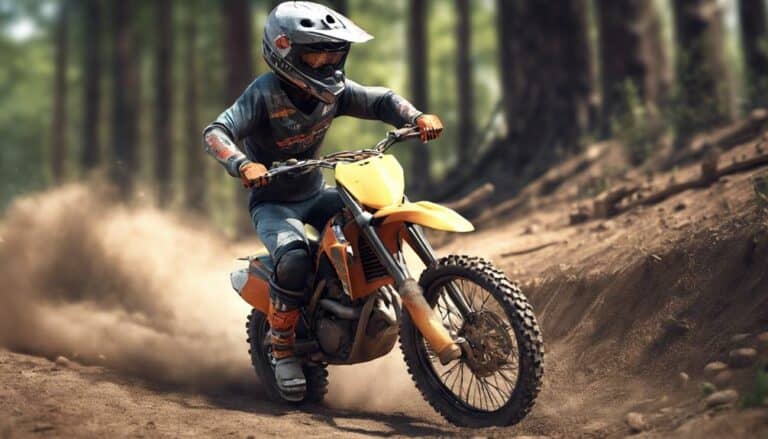When honing your dirt bike braking skills, safety should be your top priority. Mastering the art of braking involves more than just squeezing the lever. Understanding how to control your speed, especially on varying terrains, and avoiding common mistakes can be the difference between a thrilling ride and a dangerous mishap.
But what specific safety measures should you keep in mind to guarantee a smooth and secure braking experience? Let's explore the essential considerations that will enhance your dirt biking adventures.
Key Takeaways
- Proper braking technique crucial for control and weight transfer
- Adjust speed for trail conditions and practice controlled braking
- Adapt braking for different terrains to prevent skidding and maintain stability
- Prioritize safety with essential protective gear and quality equipment
Importance of Proper Braking Technique
Proper braking technique is essential for dirt bike riders to transfer weight effectively, maintain control, and prevent skidding on trails. When approaching a corner or obstacle during trail riding, using the front brake efficiently allows you to shift your weight forward, increasing traction on the front wheel. This action stabilizes the bike, reducing the risk of losing control and ensuring a smoother ride through challenging terrain.
Mastering the art of braking technique not only enhances your performance but also boosts your confidence in emergency situations. By practicing consistent and smooth application of the brakes, you develop muscle memory that enables quick reflexes when confronted with unexpected obstacles or the need for sudden stops. This muscle memory can be vital for avoiding collisions or maneuvering through tricky sections of the trail safely.
Braking Distance and Speed Control
Maintain a safe following distance to allow for adequate braking time in case of sudden stops, an important aspect of mastering dirt bike braking fundamentals.
When it comes to braking distance and speed control on your dirt bike, there are key considerations to keep in mind:
- Adjust Speed Accordingly: Always adjust your speed based on the trail conditions you're riding in, whether it's loose gravel or mud. This will guarantee that your braking is effective when needed.
- Practice Controlled Braking: To prevent skidding and maintain stability on different surfaces, practice controlled braking techniques. This will help you stop smoothly and maintain control over your bike.
- Be Mindful of Stopping Power: Understand the stopping power of your front brake lever and braking system. Knowing your bike's capabilities will help you adjust your speed for safe stopping distances.
- Maintain a Safe Following Distance: By keeping a safe distance between you and the rider in front, you provide yourself with the necessary time to brake safely in case of sudden stops. Remember, safety first when it comes to braking on your dirt bike.
Braking on Different Terrain
When riding on different terrains, adjusting your braking technique is essential for maintaining control and stability on your dirt bike. In various situations, knowing how to utilize your front brake, back brakes, or both can make a significant difference in your ability to stop safely.
On loose surfaces like gravel or sand, it's important to adapt your braking pressure to prevent skidding. Applying gradual rear brake pressure on muddy terrain helps avoid losing traction, while on rocky paths, judiciously using both brakes provides balanced stopping power.
Practicing these varying braking techniques on different terrains not only enhances your overall riding skills but also guarantees good braking habits that can keep you safe. Remember, the front brake is powerful and should be used carefully, especially in challenging conditions.
Avoiding Common Braking Mistakes
To enhance your dirt biking safety, be mindful of common braking mistakes to avoid while riding. Here are some key points to contemplate:
- Avoid locking up the rear wheel: Gradually apply pressure to the rear brake to prevent skidding, ensuring better control and stability.
- Maintain proper body position: Keep your weight back when braking to prevent loss of control and maximize traction, especially on challenging terrains.
- Utilize both brakes together: Initiate braking with the front brake to transfer weight to the front wheel for increased grip, then engage the rear brake for peak stopping power.
- Adapt to the terrain: Adjust your braking technique based on the surface conditions; for loose or slippery terrain, apply brakes gently to avoid sliding and maintain stability.
Safety Gear for Braking Practices
Are you adequately equipped with the essential safety gear for your dirt bike braking practices?
When engaging in braking techniques on your dirt bike, it's important to prioritize your safety by wearing the proper protective gear. Equip yourself with a full set of safety gear including a helmet, goggles, gloves, boots, and body armor to shield yourself from potential injuries during practice sessions.
Make sure that your safety gear fits correctly and is in good condition to provide maximum protection in case of falls or accidents while practicing braking drills. Investing in high-quality safety equipment approved for dirt biking won't only offer maximum protection but also enhance your comfort during training sessions.
Remember to regularly inspect and maintain your safety gear, replacing any damaged or worn-out pieces to uphold their effectiveness and minimize risks during dirt bike braking practices. Your safety should always come first when honing your braking skills, so gear up appropriately before hitting the trails.
Conclusion
To sum up, when practicing dirt bike braking fundamentals, always prioritize safety. Remember to use proper front brake technique to maximize control and prevent accidents.
For example, picture maneuvering a tight corner on a muddy trail – by modulating your front brake pressure, you can smoothly maneuver through the turn and maintain stability.
By following safety considerations and mastering braking fundamentals, you can enjoy a safer and more controlled riding experience.

